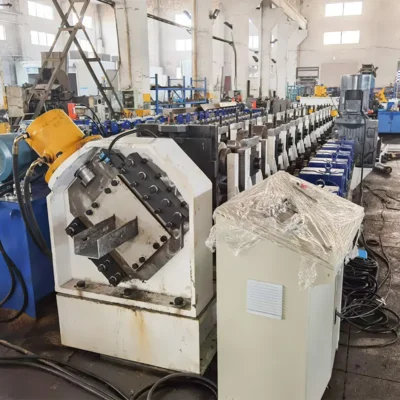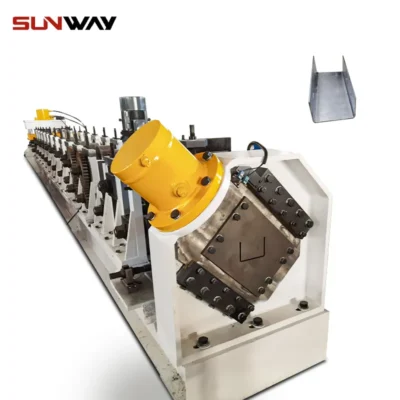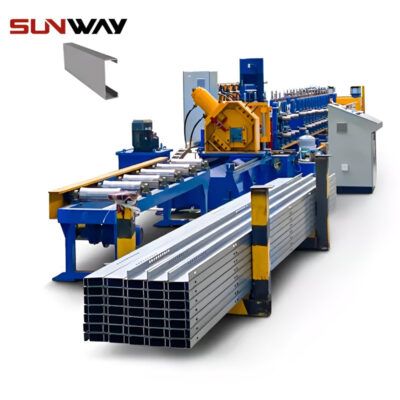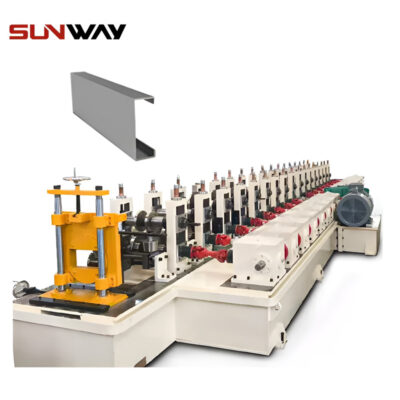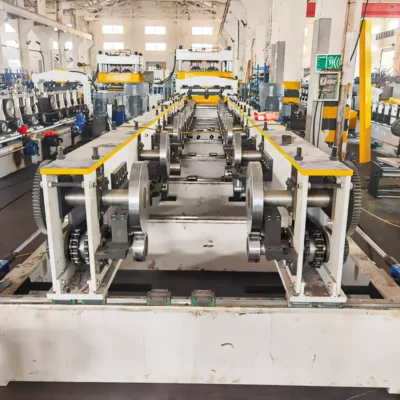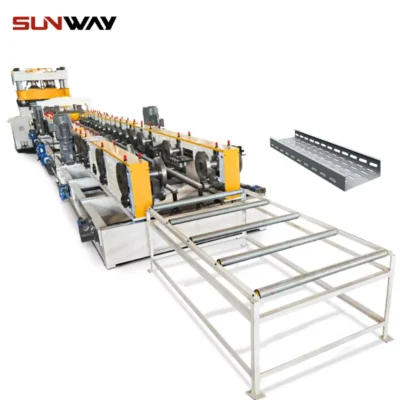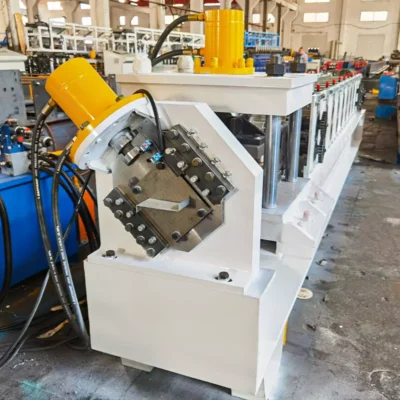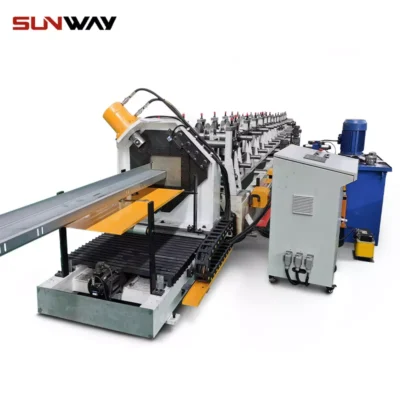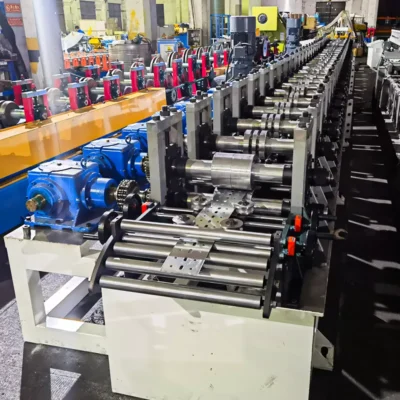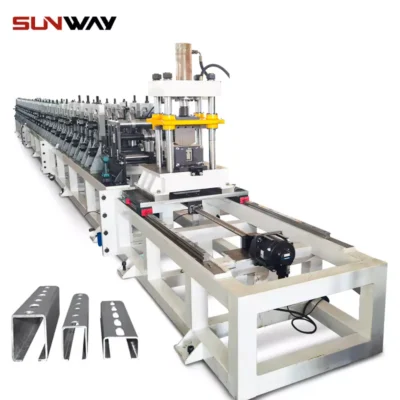As the era of automation continues to evolve, the demand for robot workstations—dedicated spaces where industrial robots perform tasks—has skyrocketed across industries. These workstations are the backbone of automation in manufacturing, logistics, and assembly lines, providing stability, precision, and modularity. At the core of producing these robust workstation frames are the Robot Workstation Frame Roll Forming Machines, a cutting-edge solution for manufacturers aiming to stay competitive in an increasingly automated world.
In this comprehensive guide, we’ll explore Robot Workstation Frame Roll Forming Machines, their applications, advanced features, pricing, and the pivotal role of Wuxi Sunway Machinery in this technological revolution. Whether you’re a manufacturer, an engineer, or a decision-maker in the industrial automation space, this guide will provide valuable insights into how roll-forming technology is shaping the future of robotics in 2025.
What is Robot Workstation Frame Roll Forming Machines?
Robot Workstation Frame Roll Forming Machines are specialized industrial machine designed to produce the structural components and profiles used in robot workstations. These machines transform raw metal coils into precise shapes, such as square tubes, U-channels, and box sections, which are then assembled into workstation frames.
Robot workstations require frames that are sturdy, precise, and modular to support the robots’ high-speed, repetitive motions. Robot Workstation Frame Roll Forming Machines ensure that these frames meet the rigorous demands of industrial automation, offering durability, dimensional accuracy, and scalability.
Applications of Robot Workstation Frame Roll Forming Machines
The profiles and frames produced by these roll-forming machines are used in a wide range of industries that rely on robotic automation. Here are the primary applications:
1. Automotive Manufacturing
- Use Case: Workstations for robotic welding, painting, and assembly.
- Why It Matters: Roll-formed frames provide the stability and precision needed for high-speed automotive production lines.
2. Electronics Assembly
- Use Case: Frames for robotic arms used in PCB assembly, soldering, and quality inspection.
- Why It Matters: Dimensionally accurate frames ensure smooth integration with robotic systems in high-tech manufacturing.
3. Logistics and Warehousing
- Use Case: Workstation frames for robotic sorting, packing, and material handling systems.
- Why It Matters: Lightweight yet sturdy frames simplify installation and enhance mobility in dynamic warehouse environments.
4. Aerospace and Defense
- Use Case: Workstations for robotic machining, composite material handling, and part assembly.
- Why It Matters: High-strength profiles meet the strict safety and performance standards of aerospace applications.
5. Food and Beverage Processing
- Use Case: Frames for robotic systems used in packaging, sorting, and quality control.
- Why It Matters: Corrosion-resistant profiles ensure hygiene and durability in food-grade environments.
6. General Manufacturing
- Use Case: Modular workstations for robotic arms performing tasks like cutting, drilling, and inspection.
- Why It Matters: Versatile frames accommodate a variety of robotic applications, enhancing operational flexibility.
Key Features of Wuxi Sunway Robot Workstation Frame Roll Forming Machines
Wuxi Sunway Machinery is a global leader in roll-forming technology, offering machines that combine cutting-edge features with precision engineering. Below are the standout features of their Robot Workstation Frame Roll Forming Machines:
1. Multi-Profile Production
- What It Offers: Machines can produce various profiles, including square tubes, C-channels, and box sections.
- Why It’s Revolutionary: Supports the production of frames for diverse robotic workstation designs and configurations.
2. Material Compatibility
- Supported Materials:
- High-strength steel
- Galvanized steel
- Stainless steel
- Aluminum alloys
- Why It Matters: Enables the production of frames that are lightweight, corrosion-resistant, and capable of withstanding heavy loads.
3. High Precision and Tolerance
- What It Does: Produces components with tight tolerances and smooth finishes.
- Why It’s Important: Guarantees seamless integration with robotic systems and reduces assembly errors.
4. Modular Design Capabilities
- What It Offers: Machines can produce profiles with modular features, such as slotted holes and snap-fit connections.
- Why It’s Revolutionary: Simplifies the assembly and reconfiguration of robotic workstations, enhancing their versatility.
5. High-Speed Production
- Performance: Machines can produce up to 40 meters of profiles per minute, depending on the design.
- Why It Matters: Meets the high-volume demands of industrial automation manufacturers.
6. Fully Automated Operations
- Features:
- PLC-controlled systems with a user-friendly interface.
- Real-time monitoring and error detection.
- Automated stacking and packaging systems.
- Why It’s Revolutionary: Reduces labor requirements while ensuring consistent quality and output.
7. Customizable Tooling
- What It Includes: Interchangeable tooling systems for quick transitions between different profile designs.
- Why It Matters: Enhances flexibility for manufacturers catering to multiple industries and applications.
8. Eco-Friendly Operation
- What It Offers: Energy-efficient motors and waste-reducing technologies.
- Why It Matters: Aligns with sustainability goals and reduces operational costs.
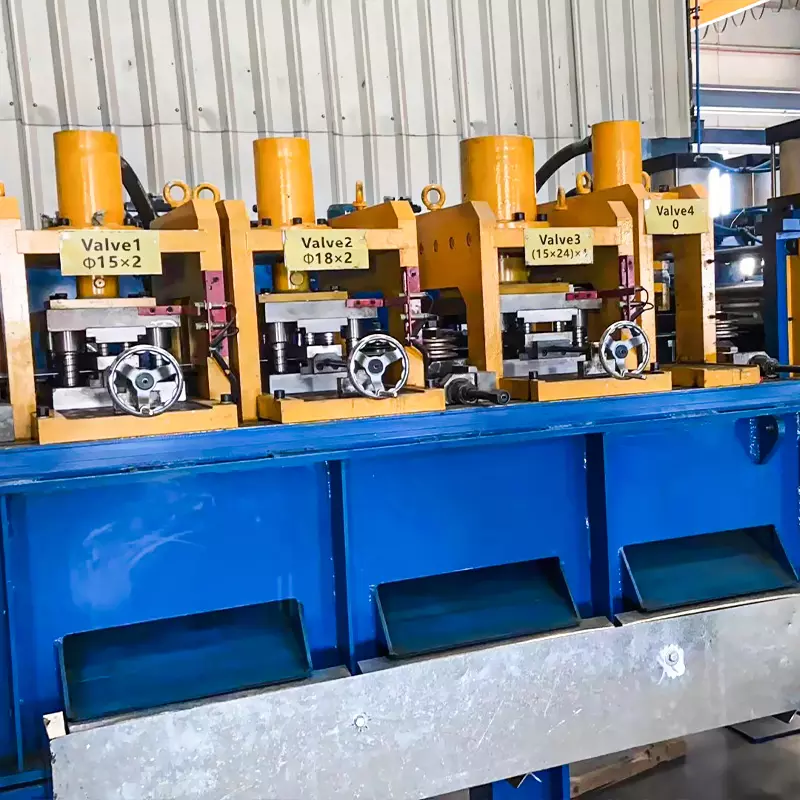
Production Workflow of Robot Workstation Frame Roll Forming Machines
The production process for robotic workstation frames is designed to ensure efficiency and precision. Below is an overview of the workflow:
1. Decoiling
- Raw metal coils are loaded onto the decoiler, which feeds the material into the machine.
2. Leveling
- A leveling system ensures the material is flat and free from warping or defects before entering the roll-forming section.
3. Roll Forming
- The material passes through a series of rollers that gradually shape it into the desired profile, such as a square tube or C-channel.
4. Cutting and Punching
- Integrated cutting units trim profiles to the required lengths, while punching systems create holes or slots for modular connections.
5. Surface Finishing (Optional)
- Additional treatments, such as powder coating or anti-corrosion finishes, can be applied to enhance durability and aesthetics.
6. Stacking and Packaging
- Finished profiles are automatically stacked and packaged for easy transportation and assembly.
Pricing of Robot Workstation Frame Roll Forming Machines
The cost of Robot Workstation Frame Roll Forming Machines depend on its features, production capacity, and customization options. Below is a general pricing guide for 2025:
| Machine Type | Capabilities | Price Range (USD) |
|---|---|---|
| Standard Machines | Basic profile production | $250,000–$400,000 |
| High-Precision Machines | Advanced tolerances and multi-profile output | $400,000–$600,000 |
| Fully Customizable Machines | Multi-material compatibility and custom features | $600,000–$1,000,000 |
For tailored pricing and financing options, contact Wuxi Sunway Machinery.
Advantages of Using Robot Workstation Frame Roll Forming Machines
Investing in a Robot Workstation Frame Roll Forming Machine offers significant benefits for manufacturers:
1. Enhanced Efficiency
- High-speed operation reduces lead times and increases output.
2. Precision and Consistency
- Ensures uniform quality across all components, minimizing assembly errors.
3. Material Versatility
- Supports a wide range of materials, including high-strength alloys and corrosion-resistant metals.
4. Cost Savings
- Reduces material waste and labor costs, improving overall profitability.
5. Scalability
- Suitable for both small-scale manufacturers and large-scale production lines.
FAQs About Robot Workstation Frame Roll Forming Machines
| Question | Answer |
|---|---|
| Can the machine produce custom profiles? | Yes, it supports multi-profile capabilities for customized workstation designs. |
| What is the production speed? | Machines can produce up to 40 meters of profiles per minute, depending on the design. |
| Does Sunway provide training? | Absolutely! Wuxi Sunway offers comprehensive training for operators and technicians. |
| What is the expected lifespan of the machine? | With proper maintenance, the machine can last 10–15 years or more. |
| Are financing options available? | Yes, flexible financing options are offered to qualified buyers. |
| Does the machine support pre-coated materials? | Yes, it is designed to handle pre-coated and pre-painted materials with precision. |
Global Trends Driving the Adoption of Robot Workstation Frame Roll Forming Machines
The surge in industrial automation and robotics is reshaping the global manufacturing landscape. Below are the key trends driving the increased adoption of Robot Workstation Frame Roll Forming Machines:
1. The Rise of Industry 4.0
- The Trend: Industry 4.0, characterized by smart factories and interconnected systems, is influencing every aspect of manufacturing, including robotic integration.
- Impact on Robot Workstations: The demand for modular and precise workstation frames that support advanced robotics is at an all-time high.
- Why It Matters: Roll-forming machines provide the dimensional accuracy and scalability required for Industry 4.0-compatible workstations.
2. Surge in Demand for Collaborative Robots (Cobots)
- The Numbers: The global collaborative robot market is projected to grow at a CAGR of 42%, reaching $11 billion by 2030.
- Impact on Robot Workstations: Cobots require frames that are modular, customizable, and ergonomically designed to work safely alongside humans.
- Why It’s Exciting: Roll-forming machines can produce profiles tailored to cobot workstations, ensuring safety and flexibility.
3. Growth in E-Commerce and Logistics
- The Opportunity: The e-commerce boom has accelerated the adoption of robotic systems for warehousing, sorting, and packaging.
- Impact on Robot Workstations: These applications require lightweight yet sturdy workstation frames that can be easily reconfigured.
- Why It’s Crucial: Roll-forming technology enables the high-speed production of frames that meet these dynamic requirements.
4. Expansion of Automotive Automation
- The Shift: Automotive manufacturers are increasingly adopting robotic systems for welding, assembly, and quality inspection.
- Impact on Robot Workstations: These workstations must withstand heavy loads and high-speed operations while maintaining precision.
- Why It Matters: Roll-forming machines provide the high-strength profiles needed for automotive-grade robot workstations.
5. Focus on Sustainability
- The Push: Manufacturers are under pressure to adopt eco-friendly practices, with many aiming to achieve net-zero emissions by 2050.
- Impact on Robot Workstations: Lightweight and recyclable workstation frames reduce the carbon footprint of automation systems.
- Why It’s Relevant: Roll-forming machines support sustainable manufacturing by minimizing material waste and enabling the use of recyclable materials.
6. Workforce Shortages in Manufacturing
- The Challenge: A global shortage of skilled labor is driving manufacturers to invest in automation.
- Impact on Robot Workstations: Modular and easily deployable workstation frames accelerate the integration of robotic systems.
- Why It’s Important: Roll-forming machines enable the rapid production of standardized frames, addressing the scalability needs of manufacturers.
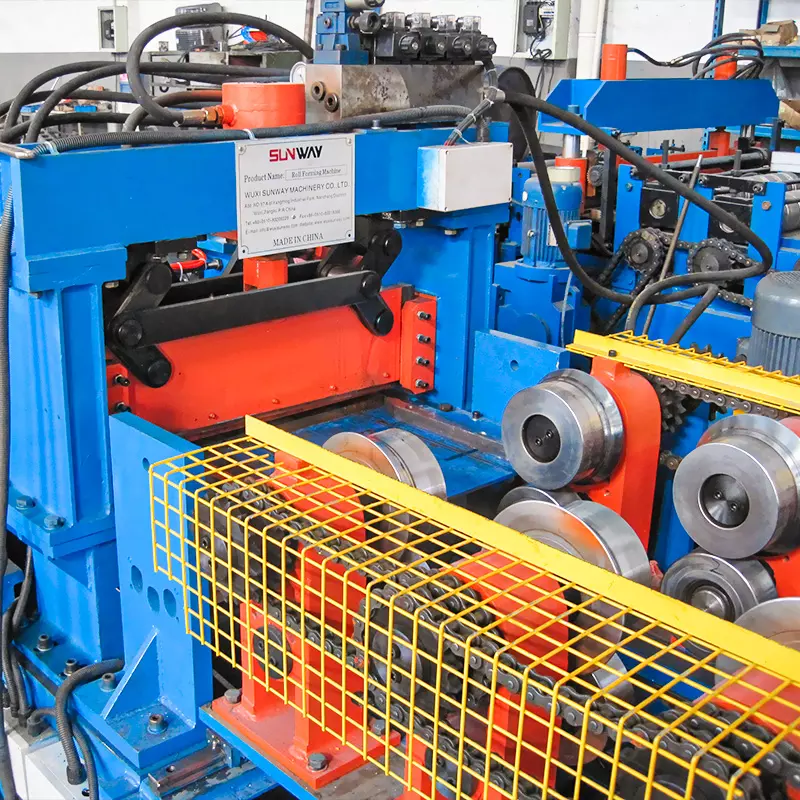
Technological Advancements in Robot Workstation Frame Roll Forming Machines
Technological innovation is at the heart of the advancements in Robot Workstation Frame Roll Forming Machines, making them faster, smarter, and more versatile. Here’s a look at the cutting-edge technologies defining the field in 2025:
1. AI-Driven Process Optimization
- What It Does: Artificial intelligence monitors production parameters, identifies inefficiencies, and adjusts machine settings in real time.
- Benefits:
- Guarantees consistent quality for all profiles.
- Reduces material waste by detecting defects early.
- Enhances overall production efficiency.
2. IoT-Enabled Smart Machines
- How It Works: Internet of Things (IoT) sensors collect real-time data on machine performance, material usage, and output quality.
- Advantages:
- Facilitates remote monitoring and diagnostics.
- Enables predictive maintenance to minimize downtime.
- Supports integration into smart factory ecosystems.
3. Multi-Material Processing
- The Innovation: Machines can now process a wider range of materials, including high-strength alloys, stainless steel, and pre-coated metals.
- Why It’s Revolutionary:
- Expands the range of applications for robotic workstations.
- Allows manufacturers to meet specific industry requirements.
- Supports lightweight yet durable frame production.
4. Servo-Driven Precision
- The Technology: Servo motors provide precise control over rollers, cutting systems, and punching units.
- Why It’s Crucial:
- Ensures flawless dimensions and smooth finishes.
- Enhances the structural integrity of workstation frames.
- Reduces energy consumption, aligning with sustainability goals.
5. Advanced Safety Features
- What It Includes: Machines feature automatic shut-off systems, overload protection, and real-time error detection.
- Why It Matters:
- Protects operators from accidents.
- Ensures compliance with industry safety standards.
- Minimizes downtime caused by equipment damage.
6. Customizable Tooling Systems
- What It Offers: Interchangeable tooling systems enable quick transitions between different profile designs.
- Why It’s Important:
- Simplifies the production of custom workstation frames.
- Reduces downtime during product changes.
- Enhances flexibility for manufacturers serving multiple industries.
Environmental Impact of Robot Workstation Frame Roll Forming Machines
Sustainability is a growing concern across all industries, and Robot Workstation Frame Roll Forming Machines are no exception. Here’s how these machines contribute to greener manufacturing practices:
1. Reduced Material Waste
- How It Works: Roll-forming technology shapes metal with precision, minimizing scrap and offcuts.
- Impact:
- Conserves raw materials, reducing environmental impact.
- Lowers material costs for manufacturers.
2. Recyclable Materials
- What It Supports: Machines can process materials like aluminum and galvanized steel, which are fully recyclable.
- Why It Matters:
- Promotes a circular economy by enabling material reuse.
- Reduces landfill waste and supports sustainable practices.
3. Energy Efficiency
- The Innovation: Modern machines consume less energy while maintaining high production speeds.
- Why It’s Crucial:
- Helps manufacturers reduce their carbon footprint.
- Aligns with global sustainability goals, such as net-zero emissions.
- Improves profitability by lowering electricity costs.
4. Localization of Production
- What It Enables: Machines allow manufacturers to produce workstation frames locally, reducing the need for long-distance transportation.
- Outcome:
- Cuts down on emissions associated with shipping.
- Enhances regional sustainability and supply chain reliability.
Additional FAQs About Robot Workstation Frame Roll Forming Machines
| Question | Answer |
|---|---|
| Can the machine handle high-strength steel? | Yes, it is designed to process high-strength steel and other durable materials. |
| What is the typical production speed? | Machines can produce up to 40 meters of profiles per minute, depending on the design. |
| Does Sunway provide post-sale support? | Absolutely! Wuxi Sunway offers comprehensive after-sales support, including maintenance and troubleshooting. |
| What is the lead time for machine delivery? | Lead times vary based on customization but typically range from 60 to 90 days. |
| Are financing options available? | Yes, flexible financing options are offered to qualified buyers. |
| Does the machine support automated stacking? | Yes, automated stacking and packaging systems are integrated into most models. |
Why Choose Wuxi Sunway Machinery for Robot Workstation Frame Roll Forming Machines?
Here’s why Wuxi Sunway Machinery is a trusted partner for manufacturers worldwide:
- Proven Expertise: Decades of experience in designing and delivering cutting-edge roll-forming machines.
- Global Presence: Trusted by clients in Asia, Europe, the Americas, and beyond.
- Customization Excellence: Machines tailored to meet specific workstation frame designs and material requirements.
- Sustainability Leadership: Eco-friendly designs that minimize waste and reduce energy consumption.
- Advanced Technology: Features like AI-powered quality control, IoT integration, and servo-driven systems.
- Comprehensive Support: From installation to troubleshooting, Sunway ensures seamless operations and customer satisfaction.
Conclusion: Advancing Automation with Robot Workstation Frame Roll Forming Machines
The Robot Workstation Frame Roll Forming Machines are a game-changer for industrial automation, enabling the efficient production of durable, modular, and customizable workstation frames. Whether you’re building robotic systems for automotive assembly, logistics, or manufacturing, these machines provide the precision, scalability, and innovation needed to stay ahead in 2025 and beyond.
Ready to elevate your manufacturing capabilities? Contact Wuxi Sunway Machinery today to explore their advanced roll-forming solutions. Together, let’s build the future of automation—one workstation frame at a time!

